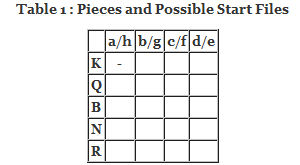
The first column in the table, covering the a/h-files, represents one of the controversial aspects of chess960 : pieces that start in the corner squares. A corner square, having only three adjacent squares, offers fewer opportunities for development than the other back rank squares, which all have five adjacent squares.
A Rook in a corner square is not controversial. That is, after all, the setup used in traditional chess. Starting in the corner, a Rook doesn't interfere with the development of the minor pieces. It just waits patiently until an open file appears on the board, then heads for that file like a boat heads for open water. The first move of a Rook is nearly always along its back rank.
Once in a while a Rook is lifted to its second rank, where it gets active play laterally, but a lift to the third rank is rare. There is a stigma attached to the early two-step move of an a/h-Pawn, making that move psychologically difficult to play. Once in a great while, the blocking Pawn disappears on a capture or an exchange to its adjacent file, opening a file for the Rook immediately.
A Knight in the corner is not particularly controversial. It has only two choices for development, where the third rank on the adjacent file is often the natural move. Going to the second rank two files away requires another move to bring the Knight into full play. This is sometimes an attractive choice when the Knight continues to a central square, like the sequence Na1-c2-e3.
A Bishop in the corner is the most controversial corner placement. The first move of the Bishop can only be on its long diagonal, which requires moving the Pawn on the adjacent file. Even if this limitation can be considered a disadvantage, the Bishop is ready for action after a single Pawn move, which is a distinct advantage.
That leaves the case of a Queen in the corner. There are three ways to activate the strongest piece. I gave examples of diagonal development in a revent post, Opening Queen Swap in the Corner, although the early Queen exchange seen there is not typical.
The Queen can also be developed along its file, by moving the blocking Pawn one or two squares. Another recent post, Activating the Corner Queen, gave an example of a Queen developed vertically. This occurs more frequently than for the Rook, because the Queen obtains a new diagonal for its second move, thereby increasing its activity.
The most popular development of the Rook -- laterally along the first rank -- is perhaps the least popular for the Queen. It requires too many moves to get the Queen into the game, although it might be interesting to collect examples of this to see the circumstances under which it occurs.
There is a choice for any player who has trouble with these many possibilities for the corner square. Stay with the traditional start position. The corner Rook maneuvers are well known and there is little need for further thinking.

No comments:
Post a Comment